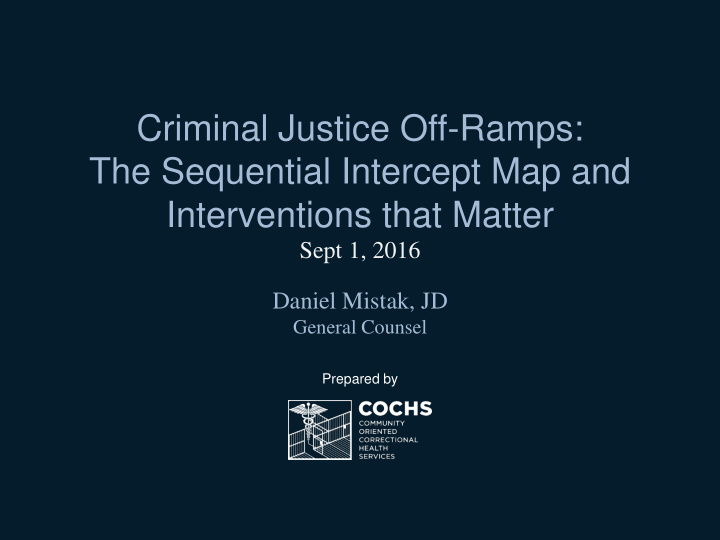



Criminal Justice Off-Ramps: The Sequential Intercept Map and Interventions that Matter Sept 1, 2016 Daniel Mistak, JD General Counsel Prepared by
The COCHS Approach: Public Safety and Community Health • Public safety and public health systems are intertwined. • Similarly, the health of the justice-involved population is intertwined with the health of the general population. • Connecting health care in the criminal justice system to health care in the greater community preserves the investments jurisdictions make in their vulnerable justice-involved populations. 2
Presentation Overview I. The State of Treatment Options II. The Sequential Intercept Model III. Lessons from Across the Country 3
The State of Treatment • In 2014, only 11% of those over age 12 with a substance use disorder (SUD) receive treatment (2.3 million out of 21.5 million) • The two most common reasons for not receiving treatment were individuals being unready to stop using and costs. • In 2014, only 45% of adults with mental health problem receive treatment • Among all adults with mental illness who did not receive mental health care, the most commonly reported reason was cost. • In 2010, 89.3 million Americans lived in federally-designated Mental Health Professional Shortage Areas Sources: http://www.samhsa.gov/data/sites/default/files/NSDUH-DR-FRR3-2014/NSDUH-DR-FRR3-2014/NSDUH-DR-FRR3- 2014.htm, http://www.bls.gov/ooh/community-and-social-service/mental-health-counselors-and-marriage-and-family-therapists.htm,
Lack of Resources Correlate with Disparities: Criminal Justice Disparities Race % General Pop % Jail Population White 69 45 Black 12 38 Hispanic 12 16 Other 7 1 A black male born in 2001 has a 32% chance of spending time in prison at some point in his life, a Hispanic male has a 17% chance, and a white male has a 6% chance. Source: Thomas P. Bonczar “Prevalence of Imprisonment in the U.S. Population, 1974–2001” (Bureau of Justice Statistics, August 2003).
Making Sense of Where We Can Intervene: The Sequential Intercept Model 6
Making Sense of Where We Can Intervene: The Sequential Intercept Model • The Sequential Intercept Model (SIM) was developed by the SAMHSA’s GAINS Center to decrease the number of mentally ill individuals in the criminal justice system. • The SIM is employed by jurisdictions across the country to assess the current care environment, to identify gaps in services, and to plan for holistic policy shifts to prevent unnecessary incarcerations. 7
The Sequential Intercept Model 8
Intercept 0: Best Clinical Practices • Intercept 0 asks questions about community service capacity. • I:0 is a new addition to the SIM and is the most fundamental. – Do you have enough providers? – Is there appropriate access to services? – Are our medical providers engaging in SBIRT? – What ways can we identify those who might be in risk of entering the criminal justice system? – Do we have systems of communication that allow for us to track the needs and treatment regimes for difficult-to-reach individuals? 9
Intercept 1: Law Enforcement and Emergency Services • Intercept 1 focuses on law enforcement and emergency services: – Who responds to calls for an opiate or mental health crisis? – Where can those individuals be taken after they are engaged by the criminal justice system? 10
Intercept 1: Law Enforcement and Emergency Services • Investments in Crisis Intervention Training (CIT) can produce staff that feel equipped to recognize and deal with behavioral health needs • Co-response teams • Pre-arrest diversion – LEAD – Pre-Arrest Diversion Centers 11
Intercept 2: Initial Hearings and Initial Detention • Intercept 2 focuses on post-arrest diversion – Who can be safely released and under what conditions? 12
Intercept 2: Initial Hearings and Initial Detention • Induction into drug and specialty courts • Managed Care Engagement • Assessments • Peer Support 13
Intercept 3: Courts and Jail • Intercept 3 focuses on courts and jails. – Who can be diverted still? – Who can be induced into medication assisted therapy? – Can we enroll individuals in Medicaid? 14
Intercept 3: Courts and Jail • Enrolling individuals in Medicaid • Ensuring that systems exist so that Medicaid remains on • Ensuring that jail providers can communicate with community providers 15
Intercept 4: Reentry • Intercept 4 focuses on reentry from prisons, jails, and hospitals. – Can individuals gain access to services? – Can individuals avoid being lost in these critical moments? 16
Intercept 4: Reentry • Establish information exchanges with community providers – “Warm handoff” • Bring peer supports into the jail before individuals are released • Enrollment, enrollment, enrollment!!! 17
Intercept 5: Community Corrections • Intercept 5 focuses on probation and parole. – Are P&P incentivized to keep individuals going to treatment? – Are systems in place that promote wellbeing and appropriate responses to relapse? 18
Intercept 5: Community Corrections • Leverage Targeted Case Management to turn P&P activities into targeted case management benefits • Create specialty caseloads • Connect folks back with Intercept 0 19
Barriers to Success • The Sequential Intercept Model is just a model – Many of the folks that you may be targeting will end up back in jail because of gaps in services. • Enrollment in Medicaid – Funding! • Housing first • Injectables like Naltrexone or buprenorphine • Criminal Records 20
What to Do with Your SIM? • First of all, make it your own! Each jurisdiction is different, and SAMHSA’s categories may not apply that well to you. • Create a repository of providers, beds, health care plans, and make this accessible to all. • Use it as documentation for the next steps or a working plan. 21
Questions Daniel Mistak dmistak@cochs.org 510.595.7360 X 16 www.cochs.org Twitter: @COCHSorg 22
Recommend
More recommend